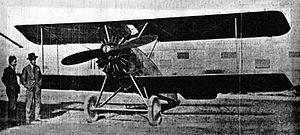Wingspan 8.17 m Retired 1938 | Length 5.79 m First flight February 11, 1927 | |
 | ||
The Chelidon (Χελιδών, meaning 'Swallow' in Greek, also spelled in English as Helithon) was the first airplane developed by the Greek EAF (KEA) aircraft factory with management provided by Blackburn Aircraft Limited at the time. According to one source, it was designed by Charles H Lowe-Wylde, although in the contemporary Jane's edition it is mentioned that "it was designed largely by Greeks" (under the supervision of Mr. Wylde), according to Greek Navy specifications. Its development was completed in the virtually record time of eight weeks, and the first flight was made on February 11, 1927. It was a two-seater military biplane designed for advanced training and other roles including reconnaissance. It could also be transformed into a hydroplane. It used a Salmson 120 hp engine (future variants were to use Armstrong Siddeley Lynx engine) and had a maximum speed of 150 km/h.
An order was originally placed (December 1926) by the Greek Navy for 18 aircraft but no further production followed, as, after the three month test flight period, it was considered inferior to alternative proposed models. The example built was used for technical personnel training at KEA and was probably scrapped in 1938.
General characteristics
Performance
